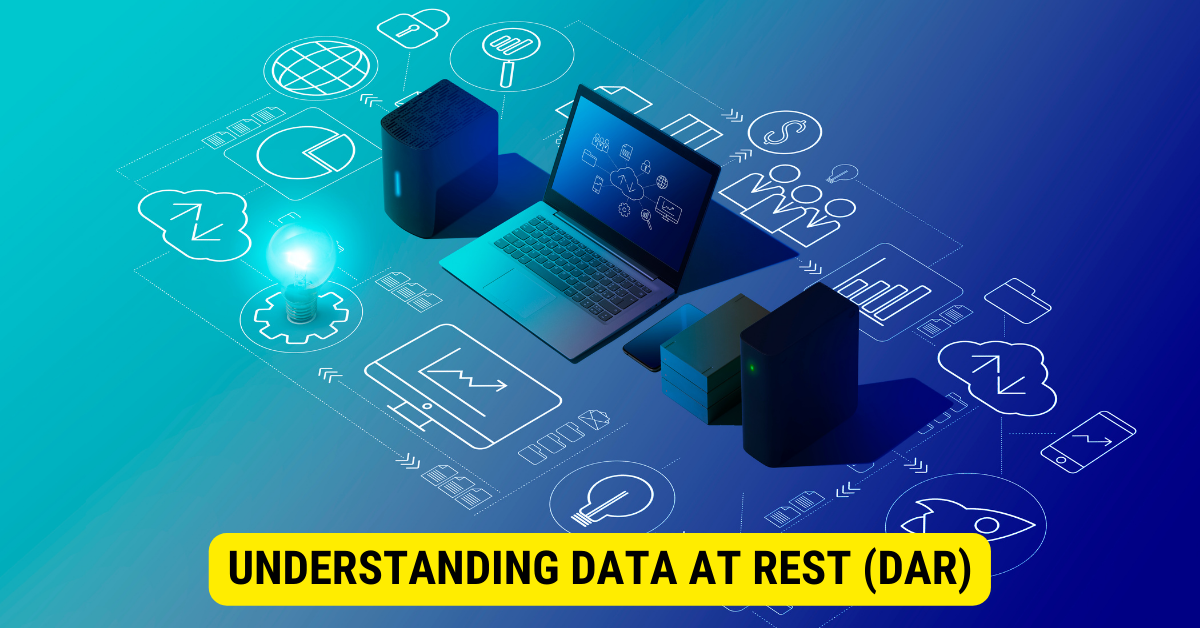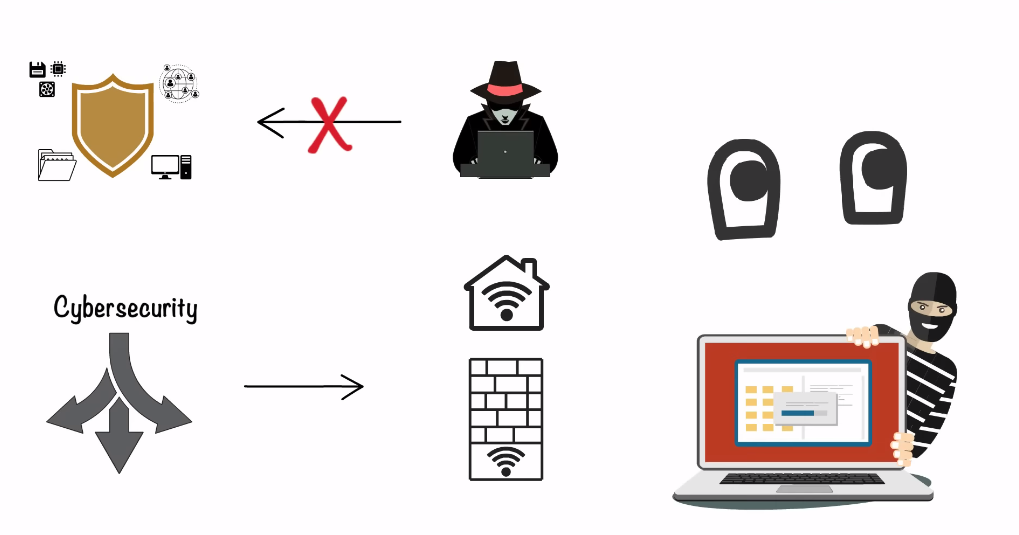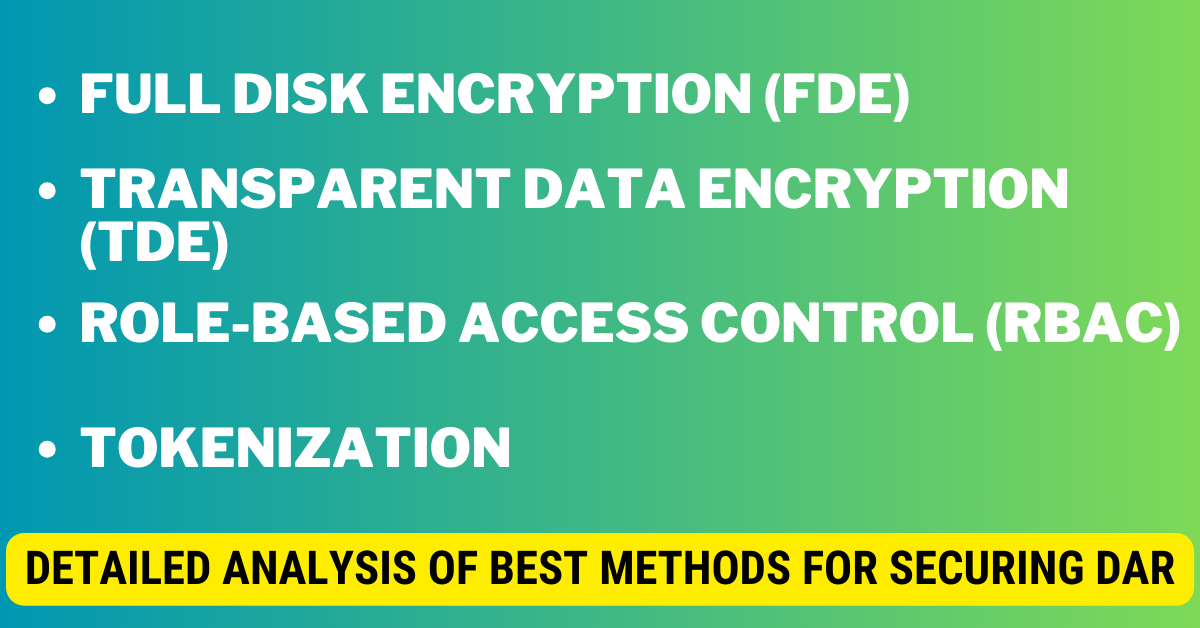The best methods for securing DAR include encryption (turning data into an unreadable format), access control (restricting who can view or use the data), data masking (hiding parts of the data), tokenization (replacing sensitive data with non-sensitive tokens), and secure data erasure (destroying data once it’s no longer needed). The choice of method depends on each organization’s specific needs and resources. Implementing robust data management policies and conducting regular security audits are key to a comprehensive data security approach.
In this rapidly digitized era, data security is becoming increasingly important. While many discussions revolve around securing data during transmission, data at rest (DAR) often gets overlooked. However, it is crucial to protect data even when it is not in use. This article sheds light on the best methods to secure data at rest, offering a comprehensive analysis of each method’s strengths and weaknesses.
Understanding Data At Rest (DAR)

Data at rest refers to any stored data that is not actively moving between systems or applications. This can contain data stored in databases, file systems, network drives, or physical storage media such as hard drives or tapes. Understanding the significance of securing data at rest is vital in safeguarding sensitive information from unauthorized access or theft.
Data at rest is a critical aspect of data security that organizations must consider. It encompasses all data in storage mediums, whether on-premises or in the cloud. This includes structured and unstructured data, files, documents, or databases that are not accessed, modified, or transmitted at a particular moment. Although seemingly dormant, data at rest still holds immense value and must be protected.
Securing data at rest is of utmost importance in today’s digital landscape. The consequences of failing to protect data at rest can be severe. Organizations may face financial loss, legal liabilities, reputational damage, and compromised customer trust. With the rising number of data breaches and cyber threats, adopting robust security measures to minimize vulnerabilities and mitigate risks is essential.
One way to secure data at rest is through encryption. Encryption transforms data into an unreadable format, ensuring that even if illegal individuals gain access to the data, they cannot decipher it without the encryption key. This adds a layer of protection to sensitive information.
Another method to secure data at rest is through access controls. By implementing access controls, organizations can restrict who can access and modify data stored in databases or file systems. This helps prevent unauthorized individuals from tampering with or stealing sensitive information.
Data backup and disaster recovery plans also play a crucial role in securing data at rest. By regularly backing up data and having a robust disaster recovery plan in place, organizations can ensure that in the event of a data breach or system failure, they can quickly restore their data to its previous state without compromising its integrity.
Furthermore, organizations must consider physical security measures to protect data at rest. This includes securing physical storage media such as hard drives or tapes in locked cabinets or data centers with restricted access. Implementing surveillance systems and monitoring access to these storage mediums can help prevent unauthorized physical access to data.
In conclusion, securing data at rest is fundamental to data security. Organizations must understand the significance of protecting stored data and not actively moving between systems or applications. Organizations can minimize vulnerabilities and mitigate risks associated with data at rest by implementing encryption, access controls, data backup, disaster recovery plans, and physical security measures.
Risks Associated with Unsecured Data at Rest
Unsecured data at rest is an open invitation for malevolent actors to exploit vulnerabilities and gain unauthorized access. Understanding the risks involved is crucial to recognize the urgency of implementing data security measures.
When data is left unsecured, it becomes susceptible to many potential threats and vulnerabilities. One such threat is the presence of insider threats, where authorized individuals misuse their access privileges. These insiders may intentionally or unintentionally compromise the security of the data, leading to unauthorized access or data breaches. Additionally, external threats pose a significant risk to unsecured data at rest. With their expertise in exploiting system vulnerabilities, hackers can easily infiltrate systems and gain access to sensitive information.
The failure to implement appropriate security measures can have severe consequences. Data theft is a primary concern when data at rest is left unsecured. Malicious actors can easily extract valuable information, such as personal or financial data, and use it for their gain. Furthermore, unauthorized data access can lead to the exposure of confidential business information, trade secrets, or intellectual property, jeopardizing the competitive advantage of organizations. Tampering with data is another potential risk, as unauthorized individuals can modify or manipulate the data, leading to erroneous decisions, loss of trust, and legal implications.
Potential Threats and Vulnerabilities
Various threats and vulnerabilities exist when data at rest is left unsecured. These can include insider threats, where authorized individuals misuse their access privileges, or external threats, such as hackers exploiting system vulnerabilities. Non-compliance to implement appropriate security measures can result in data theft, unauthorized access, or tampering.
Insider threats can arise from disgruntled employees, individuals seeking financial gain, or even unintentional errors made by employees not adequately trained in data security practices. These insiders may have access to sensitive information and can abuse their privileges to steal or leak data, causing significant harm to individuals and organizations alike.
On the other hand, external threats can come from hackers who actively seek out vulnerabilities in systems to gain unauthorized access to data at rest. These hackers employ various techniques, including brute-force attacks, phishing, and malware, to exploit weaknesses in security measures and gain entry into systems. Once inside, they can exfiltrate data, sell it on the black market, or use it for other malicious purposes.
Overview of Data Security Methods

Securing data at rest requires a multi-faceted approach involving various methods and technologies. Implementing a combination of these methods enhances overall data protection within an organization.
Data security is a critical aspect of any organization’s operations. With the increasing number of cyber threats and data breaches, it is essential to have robust measures in place to protect sensitive information. We will delve deeper into some of the most effective data security methods organizations can employ to safeguard their data.
Encryption
Encryption is a powerful method to protect data at rest. It involves transforming data into an unreadable format using encryption algorithms. Only authorized individuals with the decryption key can access and decipher the data. Encryption ensures data confidentiality and guards against unauthorized access or theft.
Various encryption algorithms are available, each with its strengths and weaknesses. Some commonly used algorithms include Advanced Encryption Standard (AES), Triple Data Encryption Standard (3DES), and Rivest Cipher (RC4). Organizations can choose the encryption algorithm that best suits their needs based on security level, performance, and compatibility.
Furthermore, encryption can be implemented at different levels, such as full disk, file-level, or database-level encryption. Each level of encryption provides an extra layer of security, making it firmer for attackers to access sensitive data.
Access Control
Access control methods restrict data access based on user roles, responsibilities, and privileges. Administrators can manage and define access rights, applying the principle of least privilege. This method prevents unauthorized individuals from accessing sensitive data, regardless of physical or virtual location.
Access control can be executed through numerous mechanisms, such as role-based access control (RBAC), mandatory access control (MAC), or attribute-based access control (ABAC). RBAC is one of the most commonly used access control models, where access rights are granted based on predefined roles assigned to users. Conversely, MAC enforces access control based on security labels assigned to data and users. ABAC considers various attributes, such as user attributes, resource attributes, and environmental attributes, to determine access rights.
Organizations can also implement additional measures to enhance access control, such as two-factor authentication (2FA) or multi-factor authentication (MFA). These methods require users to provide additional credentials, i.e a password and a exceptional code sent to their mobile device, to gain access to sensitive data.
Data Masking
Data masking involves substituting sensitive data with realistic but fictitious data. This method ensures that real data is protected while enabling organizations to use the masked data for various purposes such as development, testing, or analysis. Data masking mitigates the risk of exposing sensitive data during non-production activities.
There are different techniques for data masking, including randomization, shuffling, or substitution. Randomization involves replacing sensitive data with random values, ensuring that the masked data bears no resemblance to the original data. Shuffling involves rearranging the characters or elements of the sensitive data, maintaining the format but rendering it meaningless. Substitution replaces sensitive data with similar-looking but fictitious data, preserving the format and structure.
Data masking is useful when sharing data with third parties or conducting non-production activities. By masking sensitive information, organizations can maintain data privacy and comply with regulations while allowing authorized individuals to work with realistic data.
In conclusion, securing data at rest is a complex task that requires a combination of methods and technologies. Encryption, access control, and data masking are just a few techniques organizations can employ to protect their data. By implementing these methods and continuously updating their security procedures, organizations can diminish the risk of data breaches and ensure their sensitive information’s confidentiality, integrity, and availability.
Detailed Analysis of Best Methods for Securing DAR

While all the mentioned methods are essential for securing data at rest, specific methods have proven highly effective in ensuring comprehensive protection. This section provides an in-depth analysis of the following best methods:
Full Disk Encryption (FDE)
Full Disk Encryption (FDE) encrypts an entire storage device, ensuring that all data on the disk is protected. FDE prevents unauthorized access to data even if the storage device is stolen or lost. The encryption and decryption processes are seamless and transparent to users, requiring minimal user intervention.
Transparent Data Encryption (TDE)
Transparent Data Encryption (TDE) encrypts data at the storage level, rendering it unreadable to unauthorized users. Unlike FDE, TDE encrypts individual data files or tables rather than the entire disk. TDE provides an additional layer of database security, protecting sensitive data from theft or unauthorized access.
Role-Based Access Control (RBAC)
Role-Based Access Control (RBAC) grants or restricts access to data based on predefined user roles. It ensures that users are granted the necessary access privileges to perform their duties while preventing unauthorized access to sensitive data. RBAC simplifies access management by assigning roles and maintaining consistent organizational control.
Tokenization
Tokenization replaces sensitive data with non-sensitive tokens, removing the risk of data exposure. Tokens are randomly generated and have no relation to the original data, making it impossible to reverse-engineer the sensitive information. Tokenization enhances data protection, especially when the data needs to be used for specific purposes, such as payment processing or data analytics.
Key Takeaways
- Data At Rest (DAR) refers to data stored on physical media or in databases, and securing it is crucial due to the sensitive nature of the information it often contains.
- Common threats to DAR include unauthorized access, physical theft, insider threats, and cyberattacks.
- The most effective methods to secure DAR are data encryption, access control, data masking, tokenization, and secure data erasure.
- Each organization must choose the best method, considering its data nature and available resources.
- Implementing best practices, such as a robust data management policy, regular security audits, and employee training, is key for any successful data security strategy.
FAQs
Why is securing Data At Rest important?
Securing Data At Rest is important as it often contains sensitive information, making it a prime target for cybercriminals.
How can I choose the best method for my organization?
The best method depends on the nature of your data and available resources. It’s important to assess your data’s sensitivity, compliance requirements, and existing security measures before deciding.
What is secure data erasure?
Secure data erasure ensures that it is completely and irreversibly destroyed once it is no longer needed.
Conclusion
By understanding and implementing these best methods, organizations can meaningfully decrease the danger of data breaches and ensure data security at rest. However, it is crucial to continuously assess and bring up-to-date security measures to adapt to evolving threats in the digital landscape.
Securing data at rest should be a top priority for any organization. By embracing the best methods, such as encryption, access control, data masking, and tokenization, organizations can establish a robust security posture that safeguards data, maintains compliance, and preserves customer trust. Comprehensive data protection at rest is critical to overall data security and should not be overlooked or underestimated.
